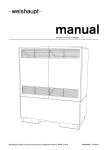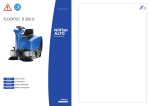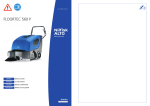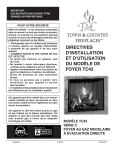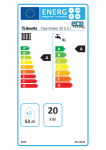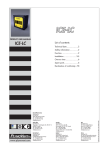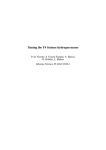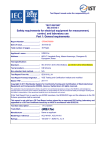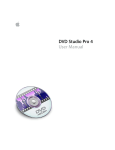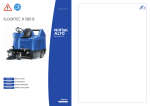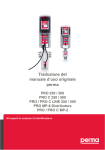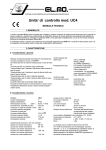Download ELECTRIC BAIN MARIE Service Manual
Transcript
ELECTRIC BAIN MARIE
700 Series
Models : 72/02CBE, 72/02TCBE, 74/02CBE, 74/02TCBE, 7-BME
Service Manual
U
.R
P
I
Z
4
S/N:
Rev.: 1.0
P
I
Z
4
U
.R
12.2.2004
Rev. 1.0
Dear Customer,
Congratulations on deciding to choose a OLIS appliance for your kitchen activities. You
made an excellent choice. We will do our best to make you a satisfied OLIS customer like
thousands of customers we have around the world.
Please read this manual carefully. You will learn correct, safe and efficient working methods in order to get the best possible benefit from the appliance. The instructions and hints
in this manual will give you a quick and easy start, and you will soon note how nice it is
to use the OLIS equipment.
All rights are reserved for technical changes.
You will find the main technical data on the rating plate fixed to the equipment. When you
need service or technical help, please let us know the serial number shown on the rating
plate. This will make it easier to provide you with correct service.
For your convenience, space is provided below for you to record your local OLIS service
contact information.
OLIS TEAM
U
.R
OLIS service phone number:...............................................................................................
P
I
Z
4
Contact person:....................................................................................................................
12.2.2004
P
I
Z
4
U
.R
Rev. 1.0
12.2.2004
Rev.
1. General information ..................................................................................... 1
1.1 Symbols used in the manual .......................................................................................... 1
1.2 Symbols used on the appliance ...................................................................................... 1
1.3 Checking correspondence between the appliance and the manual ................................ 2
2. Safety .............................................................................................................. 3
2.1 Using the appliance safely ............................................................................................. 3
2.2 Safety instructions in case of malfunction ..................................................................... 3
2.3 Disposing of the appliance ............................................................................................ 3
3. Functional description .................................................................................. 5
3.1 Intended application of the appliance ............................................................................
3.1.1 Prohibited use ........................................................................................................
3.2 Construction ..................................................................................................................
3.3 Operating principle ........................................................................................................
3.3.1 Operating switches and indicator lights .................................................................
U
.R
5
5
5
6
6
4. Operating instructions ................................................................................. 9
P
I
Z
4
4.1 Before using the appliance ........................................................................................... 9
4.1.1 Preparing the appliance for use .............................................................................. 9
4.2 Using the appliance ..................................................................................................... 10
4.2.1 Filling the tank .................................................................................................... 10
4.2.2 Turning on the appliance .................................................................................... 10
4.2.3 Daily cleaning ...................................................................................................... 10
4.2.4 Emptying the tank ................................................................................................ 11
4.3 After-use care .............................................................................................................. 12
4.3.1 Daily cleaning ..................................................................................................... 12
4.3.2 Idle period ............................................................................................................ 13
4.3.3 Routine maintenance ............................................................................................ 13
4.3.4 Non-routine cleaning .......................................................................................... 13
12.2.2004
Rev.
5. Installation ................................................................................................... 15
5.1 General information .....................................................................................................
5.1.1 Regulatory installation conditions .......................................................................
5.2 Exhausting fumes ........................................................................................................
5.3 Possible environmental interference ..........................................................................
5.4 Storage .........................................................................................................................
5.5 Unpacking the appliance .............................................................................................
5.6 Disposing of packing materials ...................................................................................
5.7 Positioning ...................................................................................................................
5.8 Electrical connections ................................................................................................
5.8.1 General information .............................................................................................
5.8.2 Connecting a type "Y" power cord to the appliance’s terminal block ................
5.8.3 Equipotential bonding terminal ...........................................................................
5.9 Water connection .........................................................................................................
5.10 Staff training ..............................................................................................................
5.11 Rating plate ................................................................................................................
U
.R
15
15
15
16
16
16
16
16
17
17
18
19
19
19
20
6. Service .......................................................................................................... 21
P
I
Z
4
6.1 Removing the control panel .........................................................................................
6.2 Replacing the heating elements .................................................................................
6.3 Replacing the drain valve ..........................................................................................
6.4 Replacing the operating thermostat ...........................................................................
6.5 Replacing indicator lights ..........................................................................................
21
22
24
25
25
7. Troubleshooting .......................................................................................... 27
8. Spare parts .................................................................................................. 29
8.1 Voltage codes .............................................................................................................. 31
8.2 Product codes ............................................................................................................... 31
9. Technical specifications .............................................................................. 39
12.2.2004
Rev. 1.0
General information
1. General information
Read the instructions in this manual carefully, as they contain important information on
how to install, use and service the appliance properly, effectively, and in a safe manner.
Keep this manual in a safe place for future reference by other operators of the appliance.
This appliance should be installed following the instructions provided by the manufacturer and in compliance with all applicable local regulations. This appliance should be connected to the power, water, and gas supply by qualified personnel only.
All personnel in charge of using this appliance should be specifically trained in its operation.
U
.R
In the event of failure or malfunction, switch off the appliance. The periodic functional
checks requested in this manual should be carried out according to the instructions. Have
the appliance serviced by a technically qualified person duly authorized by the manufacturer that uses genuine spare parts.
P
I
Z
4
Failure to comply with the above may jeopardise the appliance’s safety.
1.1
Symbols used in the manual
This symbol informs about a situation where a safety risk could be imminent. The instructions provided are mandatory in order to prevent injury.
This symbol informs about the right way to act in order to prevent bad results, damage to
the appliance, or hazardous situations.
This symbol informs about tips and hints that help the user to get the best possible performance out of the appliance.
This symbol informs about a function that should be taken into account for self-control
purposes.
1.2
Symbols used on the appliance
This symbol on a part warns the user that there are electrical terminals behind it. Therefore, the concerned part should only be removed by qualified personnel.
1
12.2.2004
Rev. 1.0
General information
1.3
Checking correspondence between the appliance and the manual
The rating plate of the appliance shows its serial number. If you have lost the original user’s manual, you can order a new one from the manufacturer or local representative. When
ordering new manuals, it is essential to quote the serial number shown on the rating plate.
U
.R
P
I
Z
4
2
12.2.2004
Rev. 1.0
Safety
2. Safety
2.1 Using the appliance safely
Being an appliance designed only for professional use, it should be operated by qualified
personnel exclusively. Never leave the appliance unattended while it is on.
Do not move the appliance while hot.
Do not use the appliance if the tank is empty.
U
.R
Keep the tank drain outlet closed.
2.2
Safety instructions in case of malfunction
P
I
Z
4
If the appliance will remain idle for some time or in the event of a failure, abnormal operation, etc., disconnect it from power supply. Call the service.
2.3 Disposing of the appliance
This appliance has been manufactured using recyclable raw materials and does not contain any hazardous or toxic substances. When disposing of the appliance and all its packing materials, ensure strict compliance with all applicable regulations in force in the
installation location. Packing materials should be separated by type and subsequently delivered to specific collection sites. Ensure compliance with environmental protection regulations.
3
12.2.2004
Safety
U
.R
P
I
Z
4
4
Rev. 1.0
12.2.2004
Rev. 1.0
Functional description
3. Functional description
3.1
Intended application of the appliance
The bain-marie is intended for holding products. The products will stay hot and keep heat
better if they are put in containers provided with lids. We also recommend using GN containers to make full use of the basin volume.
3.1.1 Prohibited use
U
.R
The bain-marie is not designed for heating up products.
3.2 Construction
P
I
Z
4
Stainless steel bearing structure resting on four height-adjustable feet. Outer covering and
worktop are all stainless steel (AISI 304).
The tank is stainless steel as well.
5
12.2.2004
Rev. 1.0
Functional description
3.3
Operating principle
Heating is obtained by means of sheathed heating elements installed outside the tank and
capable of withstanding mechanical and thermal stress.
Water temperature may be set to any position between 30°C (86°F) and 90°C (194°F).
3.3.1 Operating switches and indicator lights
By turning the thermostat knob clockwise, the power indicator light (item 3 in Fig. 1 ) will
light up. The power indicator light (item 3) will remain on until the knob is turned back
to 0.
The indicator light (item 2) lights up when temperature is within the operating range of
the thermostat and turns off when temperature reaches the set value.
U
.R
P
I
Z
4
Fig. 1
1.
2.
3.
4.
5.
6.
6
Thermostat knob
Operation indicator light
Power indicator light
Tank drain
Drain valve opening lever
Water tap
12.2.2004
Rev. 1.0
Functional description
8
7
9
Fig. 2
7.
8.
9.
"OFF" position
30°C (86°F) position (lowest temperature)
90°C (194°F) position (highest temperature)
U
.R
P
I
Z
4
7
12.2.2004
Functional description
U
.R
P
I
Z
4
8
Rev. 1.0
12.2.2004
Rev. 1.0
Operating instructions
4. Operating instructions
4.1 Before using the appliance
4.1.1 Preparing the appliance for use
Remove all packing materials and adhesive films from the appliance very thoroughly. Remove the protective plastic film from the panels, and exercise great care to ensure that no
glue traces are left on the steel surface; if necessary, use non-flammable solvents to remove glue traces. Clean the tank using hot water and a sponge.
U
.R
Prior to cooking for the first time, we recommend that you clean the appliance, and especially the tank, very thoroughly using hot water and a sponge.
Before cleaning any stainless steel parts, make sure that the detergent you intend to use
does not contain any abrasive substances and that it is suitable for stainless steel surfaces.
P
I
Z
4
After cleaning the appliance, rinse it with clean water and wipe it dry with a clean cloth.
Before you warm the appliance up for the first time, fill the tank with water up to the maximum level mark. Remember to close the drain valve.
Never place the appliance under a jet of water to clean it!
9
12.2.2004
Rev. 1.0
Operating instructions
4.2 Using the appliance
4.2.1
Filling the tank
First of all, check that the drain valve is closed (item 21 in Fig. 3),
Open the water tap (item 22) and fill the tank with water up to the maximum level mark
shown on the tank.
Fig. 3
4.2.2
U
.R
P
I
Z
4
20.
21.
22.
23.
Tank drain
Thermostat knob
Water tap
Drain valve opening lever
Turning on the appliance
•
•
•
•
Energize the appliance by turning on the safety switch installed externally;
By turning the thermostat knob clockwise, the power indicator light (item 3 in Fig.
1) will light up to indicate that the appliance is energized;
By turning the thermostat knob further on, water will start heating. Such heating is
provided by sheathed heating elements installed outside the tank and capable of
withstanding mechanical and thermal stress. Whenever heating is on, an operation
indicator light (item 2 in Fig. 1) also lights up.
Water temperature may be set to any position between 30°C (86°F) and 90°C
(194°F) (Fig. 2).
4.2.3 Daily cleaning
At the end of the working day, drain the tank as explained in paragraph "Emptying the
tank", clean it thoroughly and remove any residues or incrustations that may have formed.
Rinse the tank with clean water and dry it.
10
12.2.2004
Rev. 1.0
Operating instructions
4.2.4 Emptying the tank
The utmost attention should be given to this operation, which should be carried out only
after water has cooled down.
1.
2.
3.
Insert the drain pipe (item 30 in Fig. 5) and turn it until it remains in a vertical position.
Place a container suitable to hold all the water in the tank under the pipe.
Pull the opening lever (item 31) to the left until the drain valve opens.
U
.R
P
I
Z
4
Fig. 5
30.
31.
Drain pipe
Drain valve opening lever
11
12.2.2004
Rev. 1.0
Operating instructions
4.3
After-use care
4.3.1 Daily cleaning
Before cleaning, turn off the appliance and disconnect power supply using the safety
switch located upstream of the appliance.
Wait until the bain-marie has cooled down before you start cleaning it.
Drain all water from the tank; refer to chapter "Emptying the tank" further above.
General information
The main causes for stainless steel wear or corrosion are:
•
•
using abrasive or acid detergents, especially chlorine-based products such as hydrochloric acid or sodium hypochlorite (bleach). Therefore, before buying a cleaning product, make sure it does not corrode steel;
stagnation of ferrous deposits (such as those created by rust dissolved in the water
flowing through the piping, especially after the appliance has remained idle for
some time). Therefore, avoid such stagnation; in addition, avoid using wire scourers to remove the most stubborn food residues. Use, rather, scourers or spatulas
made of stainless steel or softer, non-ferrous materials;
stagnation of substances having acid components such as vinegar, lemon juice,
sauces, salt, etc. Therefore, avoid prolonged contact of the stainless steel parts of
the appliance with those substances. The evaporation of saline solutions over the
surfaces of the appliance is particularly harmful to them.
U
.R
P
I
Z
4
•
Routine cleaning
Cleaning the appliance thoroughly on a daily basis is the key to keeping it in perfect working condition and prolonging its life. Clean the appliance with a damp cloth using water
and soap or detergents, provided that they are not acid or abrasive as discussed further
above. Such detergents should not even be used to wash the floor near the appliance, as
their fumes may deposit on the steel surfaces and damage them. If the appliance is very
dirty, use a synthetic Scotch BriteTM type sponge. Rinse it off with clean water and wipe
it dry with a clean cloth. Do not rub the appliance with wire scourers as they could leave
rust stains. For the same reason, avoid touching the appliance with ferrous objects.
In order to prevent corrosion spots from forming, ensure that any salt residues are carefully removed from the tank’s sides and bottom.
Never use direct water jets to clean the appliance because this could result in water entering into it and damaging it.
Stains and abrasions on the steel surface
Scratches and dark stains may be smoothed or removed using stainless steel scourers or
synthetic abrasive sponges, which should always be rubbed in the same direction as the
satin finish.
12
12.2.2004
Rev. 1.0
Operating instructions
Rust
If you need to remove rust stains, contact manufacturers of industrial detergents to find a
suitable product. Industrial descaling products can also be used to that end. After using
the descaler and rinsing off the appliance with clean water, an alkaline detergent may be
required to neutralize any acid compounds left on the surface.
Cleaning the bain-marie
Occasionally, use a specific descaling product to remove any scale or incrustations that
may have built up, as explained below:
Do not breathe the vapours produced during this operation. Wear a safety mask and rubber
gloves.
4.3.2 Idle period
Turn off the safety switch fitted outside the appliance to shut off power supply to it.
4.3.3
U
.R
Routine maintenance
Only qualified personnel are allowed to carry out service and maintenance operations.
P
I
Z
4
The following maintenance operation should be carried out at least once a year:
•
checking for proper operation of all control and safety devices;
We recommend that you sign a service agreement providing for at least one check-up a
year.
4.3.4
Non-routine cleaning
Clean the bain-marie on a regular basis, about 3 to 6 times a day, depending on how often
it is used. Turn the thermostat to 0. Empty the tank according to the instructions; open the
drain valve and clean the bottom of the tank thoroughly to remove all residual dirt. Close
the drain valve and fill the tank up to the maximum level mark. Turn the thermostat knob
to the required cooking temperature.
13
12.2.2004
Operating instructions
U
.R
P
I
Z
4
14
Rev. 1.0
12.2.2004
Rev. 1.0
Installation
5. Installation
5.1 General information
The manufacturer cannot be held liable for any injuries to persons or damage to property
resulting from installation errors or from inappropriate use of the appliance and is not responsible for any faults caused by defective installation. In such cases, the warranty shall
be null and void.
Installation, maintenance, connection to power supply, and start-up should all be performed by an authorised installer who must ensure compliance with all applicable safety
regulations in force in the location where the appliance is being installed.
U
.R
Check that the appliance is pre-set to operate on the voltage available at the place of use.
Should the available voltage rating be different, do not install the appliance.
P
I
Z
4
5.1.1 Regulatory installation conditions
We remind you that all appliances installed in public assembly buildings must meet the
requirements specified below. Ensure that installation and maintenance of the appliance
are performed in strict compliance with all applicable regulations and standards in force,
namely:
•
•
•
•
•
5.2
safety regulations on fire hazard and panic in public assembly buildings;
general regulations applicable to all appliances;
heating, ventilation, refrigeration, air conditioning, and generation of steam and
hot water for sanitary use;
installation of foodservice cooking appliances;
specific regulations applicable to each type of public assembly building (hospitals,
shops, etc.).
Exhausting fumes
The appliance should be installed in a well-ventilated area, if possible under an exhaust
hood, in compliance with all applicable regulations in force, in order to ensure that cooking vapours and fumes are effectively exhausted.
15
12.2.2004
Rev. 1.0
Installation
5.3 Possible environmental interference
If the appliance is installed in the immediate vicinity of other electric appliances, make
sure that they do not interfere with each other. They should all have independent power
supplies.
5.4 Storage
If the appliance is stored in a warehouse where room temperature is below 0°C (32°F), it
should be warmed up to at least +10°C (50°F) before switching it on.
5.5
Unpacking the appliance
Prior to installation, remove all packing materials from the bain-marie. Some parts are
wrapped in adhesive film, which should be thoroughly removed (see paragraph "Preparing the appliance for use").
5.6
U
.R
Disposing of packing materials
Packing materials should be disposed of in compliance with all applicable regulations in
force at the installation location. Packing materials should be separated by type and subsequently delivered to specific collection sites. Ensure compliance with environmental
protection regulations.
P
I
Z
4
5.7 Positioning
Always close the water shut-off valves and disconnect power to the appliance before attempting to repair or service it.
Before you start working, clean the tank thoroughly and fill it with water up to the level
mark shown on the tank itself, at about 50 mm (2") from the upper edge.
Level the appliance using a bubble level. The appliance’s height can be adjusted by means
of its adjustable feet. In this way, the appliance will be firmly secured.
Ensure compliance with all workplace fire and safety regulations.
This appliance does not generate hazardous temperatures and it can therefore come in
contact with the wall.
16
12.2.2004
Rev. 1.0
Installation
5.8
5.8.1
Electrical connections
General information
The appliance must always be connected to an earthing (grounding) system while in operation.
The appliance is pre-set to be connected to the electrical switchboard. Before connecting
the appliance to the power supply network check:
•
•
•
•
•
that distribution network voltage matches the voltage shown on the appliance’s rating plate;
that the grounding (earthing) system is effective;
that the power cord is made of rubber and is of at least the same quality as cable
type H07RN-F, with wires having a cross section suited to the maximum load they
will carry (refer to "Technical specifications table" at the end of this manual);
that an effective multi-pole breaker having a contact gap of at least 3 mm was fitted
upstream of the appliance at the time of installation. Automatic thermal-magnetic
circuit breakers may be used for this purpose. The multi-pole breaker should be installed in the immediate vicinity of the appliance and be readily accessible. We
recommend fitting a thermal-magnetic circuit breaker with built-in fuse protection;
that the power cord of the appliance is not exposed to direct heat sources.
U
.R
P
I
Z
4
17
12.2.2004
Rev. 1.0
Installation
5.8.2 Connecting a type "Y" power cord to the appliance’s terminal block
The power cord can only be replaced by the manufacturer, by the manufacturer’s service
or by a technician having similar qualifications (the appliance is supplied complete with
power cord).
To access the power supply terminal block, proceed as follows:
•
•
•
•
•
disconnect power;
take out the knob (item 35 in Fig. 6);
unscrew the screw shown as item 36 to access the screw that fixes the water tap
knob;
unscrew the knob shown as item 37;
unscrew the screws shown as item 38 to remove the front panel.
U
.R
P
I
Z
4
Fig. 6
35.
36.
37.
38.
Thermostat knob
Water tap
Drain valve opening lever
Front panel fixing screws.
40.
41.
Terminal block.
Cable gland.
Fig. 7
The power cord should be locked in place with the cable gland fitted on the appliance so
as to avoid the risk of tearing it.
The length of the ground (earth) cable should be such as to allow it to suffer any possible
mechanical stress after the live leads.
18
12.2.2004
Rev. 1.0
Installation
5.8.3
Equipotential bonding terminal
The appliance should be connected to an equipotential bonding system. To that end, there
is a connection terminal with the writing "equipotential" on it (Fig. 8) on the lower left
side of the appliance, near the supply connections.
U
.R
Fig. 8
34.
35.
36.
5.9
Front left foot
Frame
Equipotential bonding terminal
P
I
Z
4
Water connection
To connect the appliance to the water supply, use either hard or soft metal tubing having
a proportionate diameter.
5.10 Staff training
Inform all personnel in charge of operating the appliance about how to use it by referring
to this user’s manual and hand them out the manual.
19
12.2.2004
Rev. 1.0
Installation
5.11 Rating plate
The rating plate showing the specifications of the corresponding model is applied in the
position shown in the installation and connection drawings and includes the data listed below:
Manufacturer:
Model:
Serial number:
Year of manufacture:
Category:
Heating power:
Natural gas consumption:
Liquid gas consumption:
Supply pressure:
natural gases: G20
liquid gases (butane/propane): G30/
G31
town gas: G110/G120
Gas inlet pipe size:
Supply voltage:
Appliance pre-set to use:
(see front page)
(see "Technical specifications table")
(see "Technical specifications table")
(see "Technical specifications table")
(see "Technical specifications table")
P
I
Z
4
U
.R
20
(see "Technical specifications table")
(see the label on the packing and on the appliance)
12.2.2004
Rev. 1.0
Service
6. Service
Always disconnect the appliance from power supply before attempting to repair or service
it.
6.1 Removing the control panel
To remove the control panel properly and gain access to the internal parts, proceed as follows:
•
disconnect power;
•
•
take out the knob (item 45 in Fig. 16);
unscrew the screw shown as item 46 to access the screw that fixes the water tap
knob;
unscrew the knob shown as item 47;
unscrew the screws shown as item 48 to remove the front panel.
•
•
U
.R
P
I
Z
4
Fig. 16
45.
46.
47.
48.
Thermostat knob
Water tap
Drain valve opening lever
Front panel fixing screws.
21
12.2.2004
Rev. 1.0
Service
6.2
Replacing the heating elements
To replace the heating elements, proceed as follows:
•
•
remove the control panel (see paragraph "Removing the control panel");
detach the power cord protective device (item 51 in Fig. 17) by unscrewing the
screws shown as item 50;
U
.R
Fig. 17
50.
51.
Screws to fix the power cord protective device
Power cord protective device
P
I
Z
4
•
disconnect all electrical connections from the terminal block after loosening the
power cord inserted into the cable gland (item 55 in Fig. 18);
Fig. 18
55.
56.
57.
58.
•
22
Cable gland.
Terminal block, electrical connection
Water inlet pipe
Pipe to distribute water into the tank
detach the water fill and distribution pipes, item 57 and item 58 in Fig. 18;
12.2.2004
Rev. 1.0
Service
•
unscrew the screws shown as item 60 in Fig. 19 and overturn the upper part of the
bain-marie;
Fig. 19
60.
61.
62.
•
•
•
•
•
Screws fixing the upper part of the bain-marie to the open stand.
Screws fixing the heating element retaining plate
Earth (ground) cable fixing screw
U
.R
unscrew the screws shown as item 61 in Fig. 19;
disconnect the earth (ground) cable;
remove the retaining plate to access the heating elements;
disconnect the electrical connections of the heating elements;
refitting the spare part is a reversal of removal.
P
I
Z
4
23
12.2.2004
Rev. 1.0
Service
6.3 Replacing the drain valve
•
•
•
•
•
remove the control panel (see paragraph "Removing the control panel");
remove the protective plate (item 70 in Fig. 20) by unscrewing the screws (item
71);
unscrew the screws (item 72) to remove the protective plate that covers the hole
provided to allow access to a spanner;
loosen the screw shown as item 73, which will allow you to unscrew the drain
valve lever;
refitting the spare part is a reversal of removal.
P
I
Z
4
U
.R
Fig. 20
70.
71.
72.
73.
24
Tank drain protective plate.
Protective plate fixing screws.
Fixing screws of the plate covering the spanner access space.
Screw fixing the lever of the tank drain valve
12.2.2004
Rev. 1.0
Service
6.4 Replacing the operating thermostat
•
•
•
•
•
Remove the control panel (see paragraph "Removing the control panel");
unscrew the screws that fix the thermostat to the frame (item 75 in Fig. 21);
detach the thermostat assembly from its support (item 76 in Fig. 21);
remove the electrical connections;
slide out the thermostat bulb from the support fixed to the tank wall (item 77) by
loosening the screws shown as item 78;
U
.R
P
I
Z
4
Fig. 21
75.
76.
77.
78.
79.
•
Thermostat fixing screws
Thermostat assembly
Sheath fixed to the heating unit.
Bulb support fixing screws
Indicator lights
refitting the spare part is a reversal of removal.
6.5 Replacing indicator lights
•
•
•
•
Remove the control panel (see paragraph "Removing the control panel");
Slide the indicator light out of its lens;
remove the electrical connections;
refitting the spare part is a reversal of removal.
25
12.2.2004
Service
U
.R
P
I
Z
4
26
Rev. 1.0
12.2.2004
Rev. 1.0
Troubleshooting
7. Troubleshooting
If the appliance fails to work, check the fuse box for blown fuses (overload protection).
Have the overload protection device checked by a qualified technician.
Users are not allowed to perform any maintenance operations on any parts of this appliance. Maintenance should be carried out by an authorized technician.
TROUBLE
POSSIBLE CAUSES
WHAT TO DO
FOR THE USER
No water heating
No power supply;
Check that the appliance is
powered;
Heating elements open
The appliance cannot be set Thermostat damaged
to low temperatures
Temperature control fails thermostat damaged;
to work
FOR THE AUTHORISED INSTALLER
U
.R
Replace them
Replace it
replace the thermostat;
P
I
Z
4
27
12.2.2004
Troubleshooting
U
.R
P
I
Z
4
28
Rev. 1.0
12.2.2004
Rev. 1.0
Spare parts
8. Spare parts
Outer parts............................................ 33
Inner parts ............................................ 35
Control thermostat............................... 37
U
.R
P
I
Z
4
29
12.2.2004
Spare parts
U
.R
P
I
Z
4
30
Rev. 1.0
12.2.2004
Rev. 1.0
Spare parts
8.1
Voltage
Voltage code
A
3/N/PE~400/230V 50Hz
B
~250V 16A 50Hz
C
3/N/PE~380/220V 50Hz
D
3/PE~200V 50-60Hz
F
2/PE 220-240V 50Hz
G
3/N/PE~415/240V 50Hz
H
3/PE~230V 50Hz
I
3/PE~220V 60Hz
J
3/PE~380 50Hz
K
3/PE~400V 50Hz
L
3/PE~415V 50Hz
M
3/PE~440V 60Hz
N
3/PE~460V 60Hz
O
3/PE~480V 60Hz
P
1/N/PE~220-240V 50Hz
R
2/PE~220-230V 60Hz
S
3/N/PE~400/230V 50Hz
T
3/PE~230V 60Hz
U
1/N/PE~100V 50-60Hz
Model codes
E
Type codes
72E
72TE
74E
U
.R
P
I
Z
4
8.2
Product code
Voltage codes
Full name
Product codes
700 Series
72/02CBE
72/02TCBE
74/02CBE
74TE
74/02TCBE
7-BME
7-BME
Accessory codes
31
12.2.2004
Spare parts
U
.R
P
I
Z
4
32
Rev. 1.0
12.2.2004
Rev. 1.0
Spare parts
ID
Type Model
Voltage Description
P-code
Module:Outer parts
10
E
10
E
7-BME
Knob
2599210
Grey Knob
2599260
20
E
Water spout
A022910
30
E
74E,74TE
False bottom
2544090
30
E
72E,72TE,7-BME
False bottom
2544080
40
E
Tank support section bar
2531848
50
E
Drain knob
A019306
60
E
74E,74TE
Basin top
2552220
60
E
72E,72TE,7-BME
Basin top
2552210
70
E
Knob
A022453
80
E
Knob
A019302
90
E
Drain extension
2519540
100
E
Foot
2519500
110
E
Green neon lens
A038507
120
E
130
E
U
.R
White neon lens
A039207
Knob gasket
2519490
E=700 Series
72E=72/02CBE, 72TE=72/02TCBE, 74E=74/02CBE, 74TE=74/02TCBE, 7-BME=7-BME
P
I
Z
4
A=3/N/PE~400/230V 50Hz, H=3/PE~230V 50Hz, P=1/N/PE~220-240V 50Hz
33
12.2.2004
Spare parts
U
.R
P
I
Z
4
34
Rev. 1.0
12.2.2004
Rev. 1.0
Spare parts
ID
Type Model
Voltage Description
P-code
Module:Inner parts
140
E
74E,74TE
Heating element
A037150
140
E
72E,72TE,7-BME
Heating element
A037050
150
E
74E,74TE
Pipe
2514546
150
E
72E,72TE,7-BME
Pipe
2514545
160
E
74E,74TE
Pipe
2514548
160
E
72E,72TE,7-BME
Pipe
2514544
170
E
Terminal block
A036204
180
E
Tap
2519004
190
E
Tap
A022501
200
E
Neon
A038506
E=700 Series
72E=72/02CBE, 72TE=72/02TCBE, 74E=74/02CBE, 74TE=74/02TCBE, 7-BME=7-BME
U
.R
A=3/N/PE~400/230V 50Hz, H=3/PE~230V 50Hz, P=1/N/PE~220-240V 50Hz
P
I
Z
4
35
12.2.2004
Spare parts
U
.R
P
I
Z
4
36
Rev. 1.0
12.2.2004
Rev. 1.0
Spare parts
ID
Type Model Voltage Description
P-code
Module:Control thermostat
210
E
Control thermostat
A046250
220
E
Change-over switch
A046001
230
E
Joining bracket
A045000
E=700 Restaurant Serie
72E=72/02CBE, 72TE=72/02TCBE, 74E=74/02CBE, 74TE=74/02TCBE, 7-BME=7-BME
A=3/N/PE~400/230V 50Hz, H=3/PE~230V 50Hz, P=1/N/PE~220-240V 50Hz
U
.R
P
I
Z
4
37
12.2.2004
Spare parts
U
.R
P
I
Z
4
38
Rev. 1.0
12.2.2004
Rev. 1.0
Technical specifications
9.
Technical specifications
Connection diagrams ................................................... 40
Installation and connection drawings......................... 44
Technical specifications table...................................... 49
CE conformity declaration .......................................... 51
U
.R
P
I
Z
4
39
U
.R
P
I
Z
4
SC00416: Wiring diagram 72/02CBE,72/02TCBE, 7-BME 1/N/PE ~ 400V 50-60Hz
12.2.2004
Rev. 1.0
Technical specifications
LE00387: key to wiring diagram SC00416
72/02CBE, 72/02TCBE, 7-BME - 1/N/PE~400V 50-60 Hz
Letter code Art. no.
Descriptions
Specifications
B1
E1
E11
E51
S1
A046250
A038506
A038506
A037050
A046000
Control thermostat
Power indicator light
Operation indicator light
Heating element
Switch
30 - 90°C - 1-ph.
400V - 150°C
400V - 150°C
2000W - 230V
SINGLE-PHASE
U
.R
P
I
Z
4
41
U
.R
P
I
Z
4
SC00417: Wiring diagram 74/02CBE,74/02TCBE 3/N/PE ~ 400V 50-60Hz
12.2.2004
Rev. 1.0
Technical specifications
LE00388: key to wiring diagram SC00417
74/02CBE, 74/02TCBE - 3/N/PE~400V 50-60 Hz
Letter code Art. no.
Descriptions
Specifications
B1
E1
E11
E51-52-53
S1
30 - 90°C - 3-phase
400V - 150°C
400V - 150°C
1500W - 230V
THREE-PHASE
A046250
A038506
A038506
A037150
A046001
Control thermostat
Power indicator light
Operation indicator light
Heating element
Switch
U
.R
P
I
Z
4
43
12.2.2004
Technical specifications
Installation drawing 72/02CBE
U
.R
P
I
Z
4
C
D
E
F
G
44
Distance between feet
Tank dimensions
Rating plate
Water inlet
Terminal block
Rev. 1.0
12.2.2004
Rev. 1.0
Technical specifications
Installation drawing 7-BME
U
.R
P
I
Z
4
C
D
E
F
G
Distance between feet
Tank dimensions
Rating plate
Water inlet
Terminal block
45
12.2.2004
Technical specifications
Installation drawing 72/02TCBE
U
.R
P
I
Z
4
C
D
E
F
G
46
Distance between feet
Tank dimensions
Rating plate
Water inlet
Terminal block
Rev. 1.0
12.2.2004
Rev. 1.0
Technical specifications
Installation drawing 74/02CBE
U
.R
P
I
Z
4
C
D
E
F
G
Distance between feet
Tank dimensions
Rating plate
Water inlet
Terminal block
47
12.2.2004
Technical specifications
Installation drawing 74/02TCBE
U
.R
P
I
Z
4
C
D
E
F
G
48
Distance between feet
Tank dimensions
Rating plate
Water inlet
Terminal block
Rev. 1.0
12.2.2004
Rev. 1.0
Technical specifications
Item
Type Model
Voltage Specification
External dimensions WxDH, freestanding unit
72E,7-BME
400x700x860/900 mm
External dimensions WxDH, freestanding unit
74E
800x700x860/900 mm
External dimensionsWxDxH, tabletop unit
72TE
400x700x280 mm
External dimensionsWxDxH, tabletop unit
74TE
800x700x280 mm
Inner cupboard dimensions
Volume with package
E
72E,7-BME
0.4 m3
Volume with package
E
74E
0.75 m3
72TE
0.16 m3
Volume with package
Volume with package
Total weight
E
74TE
0.29 m3
72E,7-BME
47 Kg
Total weight
E
74E
67 Kg
Total weight
E
72TE
30 Kg
Total weight
E
74TE
47 Kg
Rated output
E
72E,72TE,7-BME
2 KW
Rated output
E
74E,74TE
Max. current
E
74E,74TE
A
6.5 A
Max. current
E
74E,74TE
H
11.3 A
Max. current
E
72E,72TE,7-BME P
Minimum lead gauge
Minimum lead gauge
Minimum lead gauge
Supply voltage
Supply voltage
Supply voltage
4.5 KW
U
.R
8.7 A
E
74E,74TE
A
5 x 1.5 mm2
E
74E,74TE
H
4 x 1.5 mm2
E
72E,72TE,7-BME P
3 x 1.5 mm2
E
74E,74TE
A
3/N/PE ~400V 50Hz
E
74E,74TE
H
E
72E,72TE,7-BME P
P
I
Z
4
3/PE ~230V 50Hz
1/N/PE ~230V 50Hz
E=700 Restaurant Serie
72E=72/02CBE, 72TE=72/02TCBE, 74E=74/02CBE, 74TE=74/02TCBE, 7-BME=7-BME
A=3/N/PE~400/230V 50Hz, H=3/PE~230V 50Hz, P=1/N/PE~220-240V 50Hz
49
12.2.2004
Technical specifications
U
.R
P
I
Z
4
50
Rev. 1.0
',&+,$5$=,21(',&21)250,7¬&(
&(&21)250,7<'(&/$5$7,21
'(&/$5$7,21'(&21)250,7(&(
&(.21)250,7b76(5./b581*
'(&/$5$&,Ï1'(&21)250,'$'&(
6LGLFKLDUDFKHLOVHJXHQWHDSSDUHFFKLR
%DJQRPDULDHOHWWULFRVHULH1HZ
:HGHFODUHWKDWWKHIROORZLQJHTXLSPHQW
(OHFWULFEDLQPDULHVHULHV1HZ
1RXVGpFODURQVTXHO
DSSDUHLOVXLYRQW
%DLQPDULHHOHFWULTXHVJDPPH1HZ
:LUHUNOlUHQGDVVGLHVHV*HUlW
(OHNWUR:DVVHUEDHGHUVHULH1HZ
6HGHFODUDTXHHOVLJXLHQWHDSDUDWR
%DQRPDULDHOpFWULFRJDPD1HZ
0RG&%(7&%(&%(7&%(%0(
qFRQIRUPHDLUHTXLVLWLEDVLODULSUHYLVWLGDOOHVHJXHQWLGLUHWWLYH&((
U
.R
LVLQVSHFLILFDWLRQZLWKWKHIXQGDPHQWDOUHTXLUHPHQWVRIWKHIROORZLQJ(&GLUHFWLYH
HVWFRQIRUPHDX[H[LJHQFHVIRQGDPHQWDOHVGHVGLUHFWLYHVGHOD&RPPXQDXWq(XURSpHQQH
VXLYDQWHV
P
I
Z
4
HQWVSULFKWPLWGHQJUXQGOHJHQGHQ$QIRUGHUXQJGHUIROJHQGHQ(*5LFKWOLQLHQ
HVFRQIRUPHDORVUHTXLVLWRVEiVLFRVSUHYLVWRVGHODVVLJXLHQWHVGLVSRVLFLRQHV&((
&((&((&((&((
6RQRVWDWHDSSOLFDWHOHVHJXHQWLQRUPHDUPRQL]]DWH
7KHIROORZLQJKDUPRQLVHGVWDQGDUGVZHUHDSSOLHG
/HVQRUPHVKDUPRQLVqHVVXLYDQWHVIXUHQWDSSOLTXqHV
)ROJHQGHKDUPRQLVLHUWH1RUPHQZXUGHQDQJHZDQGW
+DQVLGRDSOLFDGDVODVVLJXLHQWHVQRUPDVDUPRQL]DGDV
(1(1(1(1
2/,66S$
$PPLQLVWUDWRUH'HOHJDWR
3&DQGLDJR
%ULEDQR
2/,66S$
,03,$17,3(5/$5,6725$=,21(
%5,%$12%HOOXQR,WDO\
9LD&DYDOLHULGL9LWWRULR9HQHWR
7HOHIRQROLQHHUD
)D[
KWWSZZROLVLWHPDLOLQIR#ROLVLW
&DS6RFʍ
5HJLVWURGHOOH,PSUHVH5($Q
&RGLFH)LVFDOHH3DUWLWD,9$,7
P
I
Z
4
U
.R
P
I
Z
4
U
.R
P
I
Z
4
U
.R




























































